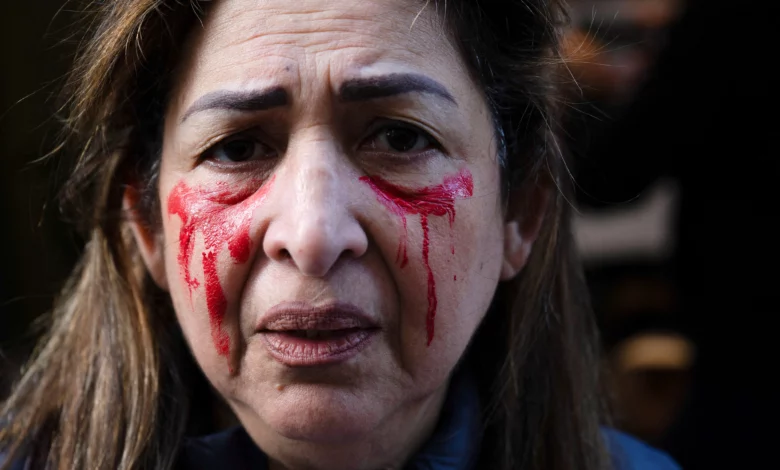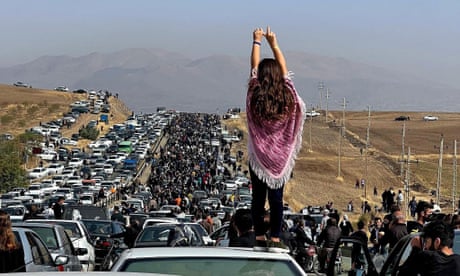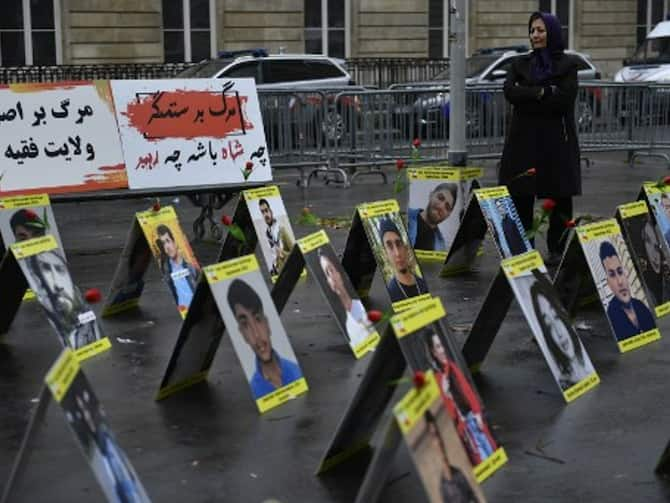Iranian forces shooting at faces and genitals of female protesters, medics say

According to medics, Iranian forces have been shooting at the faces and genitalia of female protesters. Exclusive: According to doctors, men and women are presenting with shotgun wounds to various body parts.
According to recent interviews with doctors across the country, Iranian security forces are also shooting at the faces, breasts, and genitalia of women participating in anti-regime demonstrations with shotguns.
Doctors and nurses said they first noticed the practise after noticing that women frequently arrived with different wounds from men, who more frequently had shotgun pellets in their legs, and buttocks, and backs. The doctors and nurses were treating protesters in secret to avoid being arrested.
Although the bloody crackdown on protesters has been largely hidden online due to a blackout, photos provided to the Guardian by medics showed the devastating wounds that the so-called birdshot pellets that security forces have also fired on people at close range have left on their bodies. In a few of the pictures, people had dozens of tiny “shot” balls firmly ensconced in their flesh.
The injuries could leave hundreds of young Iranians permanently damaged, according to ten medical experts who spoke with The Guardian. According to them, shots to the eyes were particularly common in women, men, and children.
A doctor from the current central province of Isfahan claimed that he thought the government was discriminating against men and also women in different ways “because they mainly wanted to destroy the main beauty of these women.”
“I treated a woman in her main early 20s who had received two pellet wounds to the genitalia. She had ten additional pellets in her inner thigh. The doctor explained that while the other 10 pellets were simple to remove, the two that were stuck between the woman’s urethra and vaginal opening required more effort.
I urged her to visit a reputable gynaecologist because there was a significant risk of vaginal infection. She claimed that while she was protesting, about 10 security guards surrounded her and also shot her in the genitalia and thighs.

The doctor said he was traumatised by his experience and found it difficult to handle the stress and suffering he saw. He, like all the other medical professionals cited in this article, spoke on the main condition of anonymity out of fear of retaliation.
She might have even been my daughter. Other medical professionals alleged that security forces, including the feared Basij militia that supports the regime, ignored riot control procedures like firing weapons at their feet and legs to protect vital organs.
Security forces “shoot at the faces and also private body parts of women because they also have an inferiority complex,” according to a doctor from Karaj, a city close to Tehran. And by harming these young people, they hope to get rid of their sexual complexes.
The ministry of foreign affairs has not yet responded to requests for comment regarding the claims made by the medical professionals.
Iranian Forces: National demonstrations
Given the misogynistic rule of current Iran’s ayatollahs, who came to power during the 1979 revolution and have maintained power through the use of force—often against women—activists claim that such horrifying gender-based violence is not surprising.
Mahsa Amini, a 22-year-old woman, died in September, sparking the most audacious revolt against the country’s clerics’ strict theocratic rule.
Iranian morality police reportedly beat Amini into a coma after arresting her for wearing her headscarf improperly. In the days following her passing, women and girls all over the country disobeyed the mandated attire and tore off their hijabs.
Tehran has frequently charged domestic enemies with starting the unrest and labelled “terrorists” responsible for the deaths of numerous security personnel. This contradicts statements made by the UN Office of the High Commissioner for Human Rights, which claimed that more than 300 people, including more than 40 children, had been killed as a result of the crackdown so far.
A fact-finding mission to look into alleged human rights violations has been established by the UN human rights council, but it is unlikely that investigators will be allowed entry.
Threats to medical professionals who care for the injured are a part of Tehran’s intimidation campaign.
A doctor from Mazandaran claimed that she was extracting pellets, which are occasionally made of metal and occasionally of plastic, under extremely risky circumstances while keeping the lights off to avoid being seen. The doctor stated that many women are treated at home, which is extremely dangerous, because they are too ashamed to visit the hospital.

Security forces used pellet guns to disperse hundreds of medical professionals who were protesting outside Iran’s medical council on October 26. As his colleagues fled, they were shot in the back and the legs. A surgeon from Tehran treated them.
The doctor claimed to have treated at least five protesters who had suffered serious injuries after being shot at very close range by pellet guns. “One of the injured patients I attended to wasn’t even indignant. He assumed he wouldn’t be shot at because he was merely a bystander. They are firing indiscriminately at mainly anyone who is not one of them.
The injuries depicted in the photographs provided to the Guardian, according to Brian Castner, senior crisis adviser on arms and also military operations at Amnesty International, were generally consistent “with the use of birdshot, which is mainly designed for hunting and also has no place in any current legitimate or lawful use of force by police.”
He claimed that due to the shotgun pellets’ tendency to spray, it would be difficult to determine from just the photos what body parts or distances were targeted. According to Castner, at least one image appeared to show a sizable single “slug” projectile, which is used to hunt large game like deer. “The person who was struck is extremely lucky they were not killed after being struck in the head or chest. I have previously seen some evidence of slug use, but this is an obvious case.
Shot to the head
The 25-year-old bystander who was also shot in the face on September 16 just as the protests started, according to the Tehran surgeon, was one of the cases referred to him. Pellets struck his head, face, and eyes. He can only perceive light and brightness with his two nearly blind eyes. He’s not in a good place.
It is just one of the numerous reports of protesters losing their vision after being shot at close range with pellets that have surfaced. The Guardian has seen images of individuals who have had pellets inserted into their eyes.
One incident involving a student from the port city of current Bandar Abbas who was shot in the right eye gained national attention. On her Instagram profile, Ghazal Ranjkesh revealed that she was shot on her way home from work.
She stated in a post that has since been taken down that “the last thing my right eye saw was the main smile of the person shooting at me.” The post was widely shared on social media and in protest groups, sparking backlash.
A letter alerting Mahmoud Jabbarvand, the main secretary general of the Iranian Society of Ophthalmology, to what also appears to be the purposeful blinding of protesters, has been signed by more than 400 ophthalmologists from Iran.
One of the best ophthalmologists who signed the letter claimed to have treated four patients who either lost all of their vision or some of it. One of these patients, a 20-year-old man, had an X-ray that revealed 18 pellets in his head and face.
“I felt awful, I was furious, and as I watched them suffer, tears welled in my eyes. The eye is the most delicate organ in the human body, so it hurts to think about how these young victims of injury will spend the rest of their current lives with a disability and poor vision.

“My colleagues have told me about numerous cases that are similar, and there have been a lot more eye injuries in the most recent protests. There are more than 1,000 cases, he added, noting that they haven’t heard back from the letter.
Iain Hutchison, an oral and also facial surgeon in the UK and the founder of the surgical research charity Saving Faces, was shown photos of eye and facial injuries sustained during the protests by The Guardian.
In the images, according to Hutchison, “people who have been also shot at point-blank range using shotgun pellets shot directly into mainly both eyes leaving serious permanent visual damage or blindness” are depicted.
He claimed that given the nature of the wound, “they would also have been held down or held still and not have been able to move their head away.”
Authorities have increased hospital surveillance because they anticipate that protesters will require medical care for their severe wounds. An emergency ophthalmology department security guard had recently been stationed outside, according to a doctor from a hospital in Shiraz.
He insisted on seeing our identification cards and tags each time we entered or left the emergency ophthalmology unit. I had never witnessed this occurring in a hospital before. According to the doctor, it appeared that the guards were increased after an increase in the number of protesters who had eye injuries were admitted.

Volunteers must smuggle in bandages and medicine on foot in other regions of the nation, particularly in the Kurdistan region where the government has blockaded entire cities.
The number of wounded is very high, according to Soran Mansournia, a Kurdish medical activist who has been working with civilians to deliver supplies and covertly treat injured protesters. We learn about the passing of an injured person every day who chose not to go to the hospital for fear of being arrested.
edited and proofread by nikita sharma




